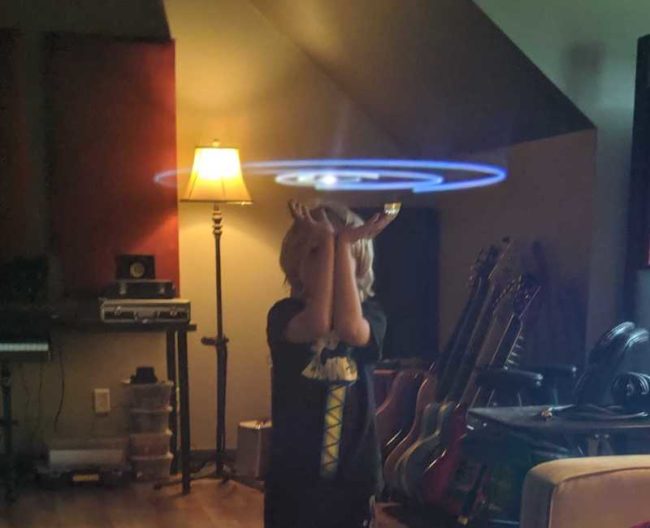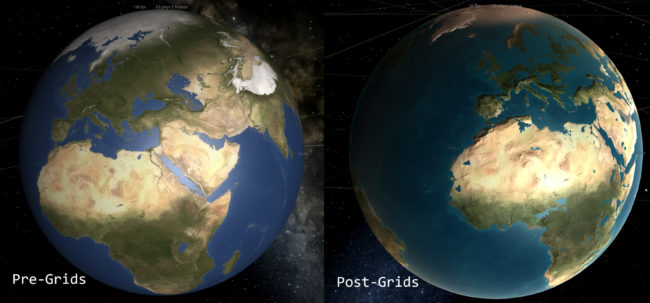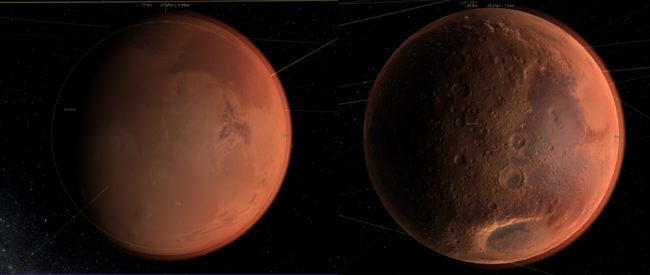Archive for July, 2019
Augmenting Our Universe on Magic Leap
Jul 31st
Video: Bouncing planets off of walls around a molten Earth.
Back in April, we announced that we received a grant to develop Universe Sandbox for Magic Leap, the augmented-reality (AR) technology that “lets you see and interact with digital content in the world around you.”
This is possible through mapping walls and objects and then superimposing images, making it seem like objects are right there in front of you. This also allows interactions between the real and digital worlds, so for example with Universe Sandbox, this means you could explore the Solar System in your living room and smash planets against your walls.
Leaps and bounds
Video: Increasing Earth’s radius until it’s as big as the room.
At that time of our last Magic Leap post, we had just gone through the Magic Leap bootcamp and had barely started on development. It didn’t take long to get to the point where it was possible to launch Universe Sandbox on the Magic Leap headset and see Earth rendered in the space around you. But this was about the extent of what was possible in the first couple of weeks.
Fast forward a few months and Universe Sandbox is now a whole new experience in Magic Leap. We’ve done a lot of work bringing the entire desktop user interface (UI) to AR. This means you’ll have the same amount of power and control you have on desktop when it comes to creating, interacting, and editing.
That’s right, all of the editable properties, all of the tools and settings and switches, they’re all available in AR. Except instead of appearing on your monitor, they appear right in the room in front of you.

Image: Our developer’s son holding up the Solar System, making Atlas’ job look easy.
We’ve also made considerable progress on getting performance to a manageable level. AR and VR are both pretty demanding when it comes to performance, as they’re dealing with more complex input and motion tracking. And for standalone hardware like the Magic Leap (and standalone VR headsets like the Oculus Quest), the hardware is necessarily more limited than what can be found in large gaming PC towers. One particular challenge for us right now is getting the interface discussed above — with its long lists of properties and settings — as fast as it should be. No one wants to wait for panels and controls to load. There’s definitely still more work to do (and in general, there will always be room for optimization with Universe Sandbox across all platforms), but we’ve gotten the experience running much more smoothly now.
Bouncing planets
Video: Launching planets toward surfaces detected by Magic Leap.
Ever play a game of racquetball where instead of a normal rubber ball you used a planet? Neither have we. But we’ve gotten pretty close to that!
It turns out that not only is it fun to smash planets against your wall, it’s also fun to let them bounce off the walls and around the room instead. This is pretty easy to do with Magic Leap, as it creates a map of your room which we then interpret as solid surfaces that are used for any type of collision.
In the video above, you can see the mesh that Magic Leap created for the walls, floors, and some objects as well.
Coming soon to VR…
In our original Magic Leap post, we also talked about how development for Magic Leap is going to improve Universe Sandbox on every other platform as well, from desktop to mobile to console*. This is especially true for VR. If you’ve played Universe Sandbox in VR, then you know the interface is fairly limited when compared to the desktop version.
This limitation will soon be a thing of the past once we make the changes to the interface we discussed above, which will bring over the whole desktop functionality. This has been a long-time coming for VR, and we’re excited to see how it’ll open up the experience. Of course, we still have some VR- and AR-specific tools and way of interacting in mind for the future that will take advantage of their unique capabilities.
Aside from this cross-platform interface, we should start to see some other changes ripple from Magic Leap development. The performance optimizations needed for AR should help with the mobile Android version, which in turn helps with a potential Oculus Quest version*. Ah, the circle of life!
We look forward to continuing Universe Sandbox development on Magic Leap through this year and seeing all our hard work pay off, not just for this unique AR experience, but for every platform in our future.
* Universe Sandbox is currently available on Windows, Mac, Linux, with support for Vive, Rift, and WMR. We are working on a mobile version (iOS and Android) as well as this Magic Leap version, and we are considering console development for the future. We’re not working on a Quest version yet, but that’s likely in our future as well. Want to receive updates about these new versions? Sign up for our newsletter!
Surface Grids & Lasers | Dev Update #7
Jul 11th

GIF: Lasering away the ice on Earth.
Here’s our round seven update on the development status of Surface Grids and Lasers. If you haven’t seen them yet, check out Dev Updates #1, #2, #3, #4, #5, and #6.
We hope you’ve been enjoying the new galaxies we added in Update 23. We still have another round of improvements and bug fixes planned for galaxies, but we’re proud of what we released and we’re shifting our excitement back to Surface Grids & Lasers.
A primer on Surface Grids for anyone not familiar:
It’s a feature we’re developing for Universe Sandbox that makes it possible to simulate values locally across the surface of an object. In effect, it allows for more detailed and accurate surface simulation and more dynamic and interactive surface visuals. It also makes it possible to add tools like the laser, which is essentially just a fun way of heating up localized areas of a surface.
Keep in mind this is a development log for a work-in-progress feature. Anything discussed or shown may not be representative of the final release state of Surface Grids. Read: Surface Grids & Lasers are not yet available in Universe Sandbox!
Gotta See It to Believe It
In the past few weeks, our graphics developer, Georg, has been taking the visual foundation that was built into the last version of Grids and plugging it into the new model.
This includes 1) getting the basics down for the shaders handling different materials and phases, from water to snow to molten silicate 2) getting all of Earth’s vegetation in the right spots 3) adding lighting, including effects for diffusion and specular and rim lighting for solar and atmospheric effects 4) and adding normal mapping.
The normal mapping creates the effect of bumps and ridges, or in other words elevation changes for things like mountains and crater rims. For a lot of visual effects, we often start with more exaggerated settings then dial it back and tweak it until we reach a more realistic appearance. In the screenshots below, the bumps are very pronounced and make for surface features that wouldn’t be discernible when viewing from space. While it’s not realistic and we plan to tone it down for the default setting, we are considering exposing this value and letting anyone set it to however they prefer.


Please note that you can safely ignore the incorrect water levels right now. We’re well aware that Europe is completely flooded and we’re working on a fix (even if it may be an accurate representation of what human-caused climate change will do to Earth…).
This visual foundation now works for planets with known heightmaps, but it will eventually be applied to all procedurally generated objects. So whether you’re lasering Earth or a randomly generated rocky planet, you’ll see the nice lighting and normal mapping.
Graphics for Surface Grids are definitely still incomplete, but everything is coming together nicely. The screenshot below shows a tidally-locked, near-Sun Earth that is frozen on the far side and molten on the near side (note: it looks especially “clean” now because it doesn’t yet include additional visual noise from blurring, blending, and randomness).

Lasers!
We haven’t shared much about lasers yet, so let’s fix that. Before, lasers were hooked up to the data side of things, so you could see its effects in the data map, but that was about it. Now that we have the visual foundation described above and can see the effects of temperature on the planet itself, playing around with lasers just got more interesting.
We recently added a radius setting that multiplies the area of effect (the laser visual itself is not yet affected by this). So whether you want to melt the whole ice cap or you want to carve your name, you can do it.
In the case of the GIF shared at the top of the post (and maybe I’m just hungry right now), this reminds me most of decorating a cake. Especially the part at the end where I do away with careful decoration and just throw a bunch of icing (er, lasering?) on the top.
We often see debates in the Universe Sandbox community about these lasers — some say they’re unrealistic and not a good use of development time, and others will stop at nothing to get their hands on them.
To the first, naysaying side we say this: Yeah, lasers like this don’t exist (at least, not yet). But… what if they did? Universe Sandbox has always been about realistic simulation of fantastical scenarios, and we think this fits very nicely into that. As for development time, lasers are a tiny fraction of the larger work on Surface Grids. They’re essentially a nice side-effect of having a system like Grids that can simulate localized surface properties, much in the same way Grids will allow us to add basic life simulation in the future as well.
And to the laser fanatics we say this: Yeah, they’re fun. Thanks for your patience!
What’s Next
There are a few higher-level things we want to get working, like being able to locally deposit water and having vapor flow connected to axial tilt. And then there are some must-fix issues like proper water level on Earth and proper phase-handling for Venus (it shouldn’t look like it’s covered in liquid water, right?). There’s also more visual work to do with blending materials and phases and handling procedurally generated objects.
So we’re a long way from the starting gate, but we’re not quite in the final stretch yet. It may be fair to say we’re at the point that was described all the way back in the second dev update: “… often times the longest and most challenging part of development comes later, when we’re tweaking, polishing, finding and fixing bugs, and making sure all the complexities of the fully fleshed out model play nicely with each other and the rest of the simulation.”
We’re definitely interested in making experimental builds available to the community in the future, before we’re ready for a full release. We’re not ready to say when these will come yet, but we hope they’re not far away.
As always, thanks for your patience and support while we work on this next big, complex feature for Universe Sandbox!
Follow @universesandbox
Future Price Increase for Universe Sandbox
Jul 3rd
We want to give everyone a heads-up that we plan to increase the price of Universe Sandbox in the near future. It’s at least a couple months away still, but we wanted to give as much advance notice as possible.
Don’t own Universe Sandbox yet? Get it for 33% off in the Steam Summer Sale
How much?
We plan to raise it from USD $24.99 to $29.99.
Localized prices on Steam and other stores will be raised accordingly.
If you already own Universe Sandbox, there will be no charge and you’ll receive updates as usual as we continue development in Steam Early Access.
When?
Probably by the end of the summer (by October 2019).
It may take longer, we don’t have an exact date yet. We plan to raise the price on the same day that we release our next major update featuring Surface Grids & Lasers. We don’t know when this will be released yet, but we’re aiming for the end of the summer. If it takes longer to get the update out, then the price increase will be delayed as well.
Why?
To support continued development of Universe Sandbox.
We love Universe Sandbox and we want to keep working on it, making it better and better for the foreseeable future. It’s why we’re hiring to expand our team, and it’s why we got rid of the “2” in our name so now we’re just Universe Sandbox. We’re in it for the long haul. The extra resources will help us continue to develop new, awesome features and expand to new platforms like mobile and console, ultimately reaching more and more people.
We appreciate everyone who has supported Universe Sandbox so far. We couldn’t have done it without you.
On sale now!
Universe Sandbox is currently 33% off in the Steam Summer Sale: Buy Universe Sandbox
We’ll definitely be on sale again in the future, but with the price increase, this may be the lowest price for Universe Sandbox for a while.
